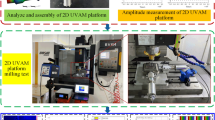Abstract
This study develops a new surface polishing approach by combining planetary motion (PM) with two-dimensional vibration-assisted magnetic abrasive finishing (PM-2DVAMAF). Planetary motion involves both rotation and revolution, thus generating radial acceleration, which strengthens the normal force exerted on the workpiece surface, and in turn enhances the cutting power of the abrasives and their polishing performance. Assisted by two-dimensional vibration, PM results in uniform, intersecting, and closely packed polishing paths, which contribute to better surface quality within a shorter processing time. This study also uses the Taguchi experimental design method to obtain the optimal combination of PM-2DVAMAF parameters for surface roughness improvement. The optimal combination obtained includes working gap, 1 mm; amplitude of vibration, 0.1 mm; particle size of steel grit, 0.125 mm; weight of SiC, 3 g; weight of steel particles, 0.5 g; weight of machining fluid, 5 g; frequency of vibration along the X- and Y-directions, 16.67 Hz; and rotational speed of magnet, 500 rpm. Experimental results reveal that 12.5-min PM-2DVAMAF under optimal combination of parameters can reduce surface roughness of a stainless steel SUS304 workpiece from 0.14 to 0.032 μm, an improvement rate of 77.1 %. PM-2DVAMAF can indeed improve surface quality with a short machining time and less abrasives required, both of which contribute to cost reduction and more environmentally friendly machining method in industry.
Similar content being viewed by others
References
Mulik RS, Pandey PM (2011) Magnetic abrasive finishing of hardened AISI 52100 steel. Int J Adv Manuf Technol 55(5–8):501–515
Amineh SK, Tehrani AF, Mohammadi M (2013) Improving the surface quality in wire electrical discharge machined specimens by removing the recast layer using magnetic abrasive finishing method. Int J Adv Manuf Technol 66(9–12):1793–1803
Givi M, Tehrani AF, Mohammadi A (2012) Polishing of the aluminum sheets with magnetic abrasive finishing method. Int J Adv Manuf Technol 61(9–12):989–998
Liu ZQ, Chen Y, Li YJ, Zhang X (2013) Comprehensive performance evaluation of the magnetic abrasive particles. Int J Adv Manuf Technol. doi:10.1007/s00170-013-4783-6
Shinmura T, Takazawa K, Hatano E (1986) Study on magnetic abrasive finishing (1st report): process principle and a few finishing characteristics. J Jpn Soc Precis Eng 52:851–857
Shinmura T, Hatano E, Takazawa K (1986) Development of plane magnetic abrasive finishing apparatus and its finishing performance. J Jpn Soc Precis Eng 52:1080–1086
Kim JD, Choi MS (1997) Study on magnetic polishing of free-form surface. Int J Mach Tool Manuf 37:1179–1187
Lee YH, Wu KL, Bai CT, Liao CY, Yan BH (2013) Two-dimensional vibration-assisted magnetic abrasive finishing of stainless steel SUS304. Int J Adv Manuf Technol 69:2723–2733
Mulik RS, Pandey PM (2010) Mechanism of surface finish in ultrasonic-assisted magnetic abrasive finishing process. Mater Manuf Process 25:1418–1427
Mulik RS, Pandey PM (2011) Ultrasonic assisted magnetic abrasive finishing of hardened AISI 52100 steel using unbonded SiC abrasives. Int J Refract Met Hard Mater 29:68–77
Yin S, Shinmura T (2004) Vertical vibration-assisted magnetic abrasive finishing and deburring for magnesium alloy. Int J Mach Tools Manuf 44:1297–1303
Wang Y, Hu D (2005) Study on the inner surface finishing of tubing by magnetic abrasive finishing. Int J Mach Tools Manuf 145:43–49
Jain VK, Kumar P, Behera PK, Jayswal SC (2001) Effect of working gap and circumferential speed on the performance of magnetic abrasive finishing process. Wear 250:384–390
Hung CL, Ku WL, Yang LD (2010) Prediction system of magnetic abrasive finishing (MAF) on the internal surface of cylindrical tube. Mater Manuf Process 25:1404–1412
Singh S, Shan HS, Kumar P (2002) Parametric optimization of magnetic-field-assisted abrasive flow machining by the Taguchi method. Qual Reliab Eng Int 18:273–283
Liao HT, Shie JR, Yang YK (2008) Applications of Taguchi and design of experiments methods in optimization of chemical mechanical polishing process parameters. Int J Adv Manuf Technol 38:674–682
Yang LD, Lin CT, Chow HM (2009) Optimization in MAF operations using Taguchi parameter design for AISI304 stainless steel. Int J Adv Manuf Technol 42(5–6):595–605
Mali HS, Manna A (2012) Simulation of surface generated during abrasive flow finishing of Al/SiCp-MMC using neural networks. Int J Adv Manuf Technol 61:1263–1268
Prabhu S, Vinayagam B (2012) AFM investigation in grinding process with nanofluids using Taguchi analysis. Int J Adv Manuf Technol 60:149–160
Author information
Authors and Affiliations
Corresponding author
Rights and permissions
About this article
Cite this article
Lee, YH., Wu, KL., Bai, CT. et al. Planetary motion combined with two-dimensional vibration-assisted magnetic abrasive finishing. Int J Adv Manuf Technol 76, 1865–1877 (2015). https://doi.org/10.1007/s00170-014-6370-x
Received:
Accepted:
Published:
Issue Date:
DOI: https://doi.org/10.1007/s00170-014-6370-x




